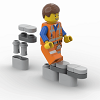| Welcome, Guest |
You have to register before you can post on our site.
|
| Forum Statistics |
» Members: 5,542
» Latest member: Seth Bray
» Forum threads: 6,314
» Forum posts: 52,574
Full Statistics
|
| Online Users |
There are currently 195 online users.
» 1 Member(s) | 189 Guest(s)
Applebot, Baidu, Bing, Google, Yandex, stas1999
|
| Latest Threads |
Vertex precision
Forum: Official File Specifications/Standards
Last Post: Orion Pobursky
Yesterday, 21:58
» Replies: 5
» Views: 1,600
|
LEGO Parts Guide - Only 6...
Forum: Part Requests
Last Post: tom alphin
Yesterday, 20:47
» Replies: 5
» Views: 236
|
98138pb0.dat is missing i...
Forum: Parts Authoring
Last Post: Magnus Forsberg
Yesterday, 15:31
» Replies: 2
» Views: 115
|
How can I install on linu...
Forum: Help
Last Post: Orion Pobursky
Yesterday, 4:48
» Replies: 1
» Views: 78
|
Castle Ninja / Robber
Forum: Part Requests
Last Post: Carl Rodabaugh
Yesterday, 1:06
» Replies: 0
» Views: 76
|
help finding ldraw for el...
Forum: Help
Last Post: Brian H
2025-12-30, 23:22
» Replies: 2
» Views: 121
|
Missing Opal Trans Yellow
Forum: Official File Specifications/Standards
Last Post: Philippe Hurbain
2025-12-30, 19:27
» Replies: 3
» Views: 262
|
LEGO Icons 2025
Forum: Official Models
Last Post: Philippe Hurbain
2025-12-30, 9:53
» Replies: 4
» Views: 5,115
|
Minifigure, Head Brown Ey...
Forum: Part Requests
Last Post: Philippe Hurbain
2025-12-30, 9:20
» Replies: 2
» Views: 164
|
Technic 1992
Forum: Official Models
Last Post: Takeshi Takahashi
2025-12-28, 19:34
» Replies: 29
» Views: 42,320
|
|
|
| Detecting current editing plane using API? |
|
Posted by: David Manley - 2021-12-28, 2:44 - Forum: LDraw Editors and Viewers
- Replies (3)
|
 |
Hi Roland,
is there an API call which returns the current editing plane? Something which perhaps returns a value of 1, 2 or 3?
By way of an example, when ctrl+R is pressed to open the Manual Rotation dialog, it knows the current editing plane to apply the rotation to. I'm wanting to modify the part alignment scripts to work based on the current rotation plane rather than making the user identify the X, Y or Z plane to be rotated around.
If an API call isn't available, can you guide me in the direction of a possible approach to try?
Thanks and regards,
David
|

|
|
| James Jessiman Memorial Award for 2021 awarded to Leonardo Zide |
|
Posted by: Willy Tschager - 2021-12-23, 15:18 - Forum: LDraw.org Announcements
- Replies (6)
|
 |
The LDraw.org Steering Committee is pleased to announce that the 2021 James Jessiman Memorial Award (JJMA) recipient is Leonardo Zide.
Leonardo got involved with digital LEGO in the 90s, when he started developing LeoCAD. Later he heard about the L-CAD mailing list in rec.toys.lego and met the early members of the LDraw community there.
LeoCAD was created initially as a standalone application, with its own parts library and file format, but soon it was updated to adopt the LDraw library and file format. It gets regular updates and is part of the LDraw All-In-One-Installer.
Leonardo authored a few parts and contributed fixes to existing parts early on but isn't involved with parts creation anymore. He's a programmer and works with people in the community to develop ideas for the library and file format.
More information on the JJMA can be found at: https://www.ldraw.org/article/222.html
On behalf of the LDraw Steering Committee, we thank Leonardo for his contributions and look forward to working with him in the future.
Willy Tschager
|

|
|
|